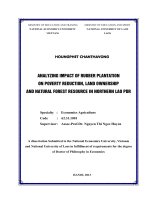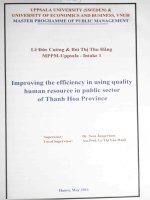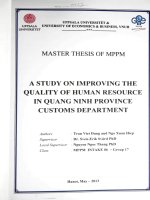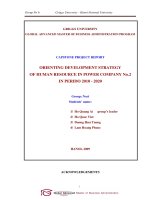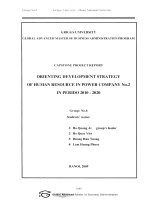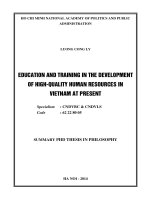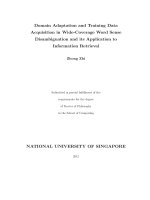developing and training human resource in pvfc
Bạn đang xem bản rút gọn của tài liệu. Xem và tải ngay bản đầy đủ của tài liệu tại đây (453.33 KB, 78 trang )
MINISTRY OF EDUCATION AND TRAINING
NATIONAL ECONOMICS UNIVERSITY
NEU BUSINESS CHOOL
NGUYEN HONG NHUNG
DEVELOPING AND TRAINING
HUMAN RESOURCE IN PVFC
MASTER OF BUSINESS ADMINSTRATION THESIS
SUPERVISOR: TRAN THI HONG VIET. Ph.D
1
ACKNOWLEDGEMENTS
Firstly, I want to express my deep gratitude to Ms Tran Thi Hong Viet, Ph.D
for her supports and advices to help me complete this thesis. She has been an
outstanding advisor, always very flexible and willing to let her students work
at their own pace, while making sure that things are going all right. I always
found her highly accessible and I thank her for the weekly meeting that kept
me motivated and suggested idea to complete my thesis.
Secondly, without the kind support of board of directors, managers and
employees of Petro Vietnam finance company (PVFC) for their participation
in my survey, my thesis never becomes such a real case so I would like to
express my great acknowledge to them.
Moreover, I thank Ms Duong for reminding me to submit thesis on time and
others supports in the process of writing thesis.
Last but not least, I also want to express my thanks to my family who gave
me enthusiastic support and shared house work with me during the last two
years while I was doing my master study.
Thank you very much.
Hanoi, May 2008
Nguyen Hong Nhung
2
TABLE OF CONTENTS
ACKNOWLEDGEMENTS 2
TABLE OF CONTENTS 3
LIST OF ABBREVIATIONS: 5
LIST OF FIGURES 6
LIST OF TABLES 6
LIST OF APPENDICES 7
CHAPTER I: INTRODUCTION 8
1.1 Necessity of research 8
1.2 Research objectives 9
1.3 Research question 10
1.4 Research methodology 10
1.5 Scope of research 12
1.6 Limitation 12
1.7 Structure of thesis 12
CHARTER II: THEORETICAL BACKGROUND 14
2.1 Overviews of human resource and human resource development 14
2.2 Nesecity of development and training human resource in business 17
2.3 Content of training and development human resource in business 18
2.4 Method of training and development human resource in business 19
2.5 Process of HR training and development in business 21
CHAPTER III: HUMAN RESOURCES DEVELOPMENT AND TRAINING ACTIVITY IN PVFC 25
3.1 An Overview of PVFC 25
3.2 Current situation of human resource development and training in PVFC 32
3.2.1 Findings on current situation of HR at PVFC 32
3
3.2.2 Findings on current situations of HR training and development at PVFC 44
3.2.3 The problems and reason of the problems 56
CHAPTER IV: RECOMMENDATIONS FOR IMPROVING HR DEVELOPMENT AND TRAINING ACTIVITY
AT PVFC 58
4.1 PVFC’S BUSINESS STRATEGY 58
4.2. Requirement for developing HR and Training needs in PVFC: 64
4.3. Recommendations for improving development and training activity at PVFC: 65
4.3.2 Improving financial capacity for training and development activity 66
4.3.3 Increasing quality of training 67
4.4 CONCLUSION 70
Experience at PVFC: 76
4
LIST OF ABBREVIATIONS:
HR : HUMAN RESOURCE
HRM : HUMAN RESOURCE MANAGEMENT
PVFC : PETRO VIETNAM FINANCE COMAPANY
WTO : WORLD TRADE ORGANIZATION
MOF : MINISTRY OF FINANCE
MPI : MINISTRY OF PLANNING AND INVESTMENT
5
LIST OF FIGURES
Page
Figure 1-1: Number and percent of people evaluate the suistability between current job with own
ability 36
Figure 1-2: Number and percent of people evaluate the suistability vailable knowledge between
with current job 37
Figure 1-3: Number and percent of people evaluate the satisfaction of their experience and skills
with their current job 38
Figure 1-4: Number and percent of people evaluation about the suistability between PVFC’ HR
ability with their current job 39
Figure 1-5: Number and percent of people rating about PVFC’ HR ualification 40
Figure 1-6: Number and percent of people rating about skills and nowledge of PVFC’s HR 41
Figure 1-7: Number and percent of people - the training contents which attended suitable with
PVFC’s business objective sand necessary for job 51
Figure 1-8: Number and percent of people - the training programs which have attended good to
improve work performance 52
Figure 1-9: Number and percent of people - put in order the following items which make to
improve development and training activity of PVFC 53
LIST OF TABLES
Table 1.1: PVFC’s business results from 2002 to 2006 31
Table 1.2: Scale and structure of PVFC HR in terms of education/ unit (person) 33
Table 1.3: Scale and structure of PVFC HR in term of age 33
Table 1.4: Responding percentages of PVFC’ staff 35
Table 1.5: Responding percentages of PVFC’ staff 38
Table 1.6: Responding percentages on policies and their impact to quality of work performance.43
Table 1.7: Number of staff participated in training courses over the years 48
Table 1.8: Staff point of views on content of training courses 49
6
Table 1.9: The people participate in the training courses in VN and foreign country 50
Table 1.10: The cost of training activity in VN and foreign country 50
Table 1.11: The detail of training activity in foreign country in 2007 in PVFC 54
Table 1.12: The investment of training HR in PVFC 55
LIST OF APPENDICES
Appendix 1: Survey Questionnaire (for staff)
Appendix 2: In depth interview questions (for managers)
Appendix 3: The organizational chart of PVFC.
7
CHAPTER I: INTRODUCTION
1.1 Necessity of research
Human resource is one of the most important resources in every organization
because of its human aspect. Having a good human resource creates big
advantages for company to get success on the market. Management of
Human resource is both art and science. A company which managers people
well will be possible to get a high quality human resource. Of all contents of
human resource management, development and training of HR is one of the
most necessary and important ones for an organization to improve quality of
its HR.
Petro Vietnam Finance Company is a state owned company, a non-banking
credit institution and a wholly owned subsidiary of Petro Vietnam, was
established according to the Decision No 04/2000/QD-VPCP dated 30th
March, 2000 by Director of Government’s Office. PVFC is now operating
with a head office in Hanoi and 8 branches in Vung tau, Da nang, Hai phong,
Can tho, Nam dinh, Sai gon, Thang long, Hanoi, with a total of 1200
employees as a date. Its objective is to become a top-ranking financial
institution in Vietnam. By 2015, PVFC will have to become the most
important Finance Holdings and the backbone of Petro Vietnam and to meet
the maximize demand of Petro Vietnam’s projects. PVFC’s strategy
throughout the development process relies on its fame, financial capability,
and financial demand of Petro Vietnam, making PVFC become a leading
financial group, in both capital scale and banking technology. Which fulfill
the requirement to cooperate and integrate with other financial institutions in
Vietnam and in the world. Being able to meet the investment demand, capital
8
investment management and operating in financial market, capital market of
Petro Vietnam.
After joining the World Trade Organization of VN in the 1
st
2007, there are
many new banks and financial institutions established in Viet Nam. In the
situation new, PVFC has to face with the following difficulties:
Firstly, intense competition from domestic credit and financial
organizations who are increasingly improving their organizational scale
and structure as well as from oversea financial corporations.
Secondly, threats of hard competition after Vietnam became a member
of WTO. Those are the competition from foreign competitors who have
strong financed capacity, advanced technology and especially business
experiences.
Thirdly, there is a shortage of PVFC’ resources to cope with the
development. Especially, human resource _ key success factor are
representing the problems that reduce the development. The company
has no long term human resource development plan. Staff of PVFC are
educated but lack of experience. Training plan are very poor. Training
content is not updated.
For the above reasons, development an training of HR is always the urgent
and the first priority of PVFC.
1.2 Research objectives
This thesis aims to get the following objectives:
To systematize theory relating on development and training of HR.
9
To identify the requirements of human resource to keep up with the
future situation and business objectives of PVFC.
To evaluate quality of work performance to determine actual situation
about skills, knowledge and attitudes of the staff of PVFC.
To define the specific gaps between current situation and future
requirement as well as find out problems of human resource
development and training of PVFC.
To propose some appropriate recommendation for improving training
activities and developing human resource in PVFC.
1.3 Research question
What are the requirements for developing HR in PVFC to meet its
future development?
What is current situation of quality and performance of HR in PVFC ?
What problems are PVFC facing in development and training of its HR
that affect to quality and performance of HR ?
What should be done to improve quality and performance of HR in
terms of HR development and training ?
1.4 Research methodology
This research has used both primary and secondary data.
The secondary data has been collected through PVFC business report, reports
and studies done by the ministry of finance, ministry of planning and
investment, articles in vietnamese and foreign newspapers and magazines,
textbook and internet. The primary data were collected by surveys and in
10
depth interviews. The quantitative surveys were completed with 150
questionnaires sending to PVFC’ staff in Hanoi, Ho Chi Minh, Can Tho,
Vung Tau, Hai Phong, Nam Dinh and Thanh Hoa province, 100 of which
were return. The in depth interview were also planned to enrich the data
collected and bring more explanations to the results concluded through the
surveys.
The questionnaires are designed into 2 main parts: Part 1 aims to collect
general information about the position, job title, knowledge and practical
experience of the respondents; Parts 2 aims to get the respondents’ opinions
on PVFC’ current situation of quality and performance of HR and their need
for developing and training , and their suggestions for improvements; The
questionnaire was originally made in Vietnamese and later on was translated
into English as attachment to this thesis.
With the aim to support for basic data and information collected by
quantitative methods above,16 in depth interviews were made to PVFC’
CEO and managers of PVFC. Beside getting information about current
situation of HR and HR developing and training at PVFC, the questions for
manager also aim to know the requirements and PVFC’ s HR developing
strategy to meet its future business development. Based on gap between
current situation and future requirements, the appropriate suggestions will be
proposed to improve HR developing and training activity. The author of this
thesis is a member of PVFC who did not face any barriers in collecting the
data and have succeeded in getting valuable information for the research.
Analyzing data: Based on the information collecting from interviews and
survey, the thesis used quantitative and qualitative methods to analyse and
process the information. The excel program has been used.
11
1.5 Scope of research
Content of the thesis focuses mainly on development and training of HR.
However, to have a deep understanding the development of HR, it is
necessary to identify and analyse other factors that impact to the process such
as HR planning, recruitment, motivation and evaluation of HR. The research
takes place within the head office of PVFC and 8 braches in Da Nang, Ho Chi
Minh, Vung Tau, Can Tho, Nam Dinh, Hai Phong, Thang Long and Sai Gon.
The data are collected for the time period of 2002-2006.
1.6 Limitation
A more appropriate survey requires to be done with larger sample size, in as
much as possible PVFC over the country. With this reason, the PVFC’ staff
are studied to get data for evaluation and taking sample. Accuracy of
information is also constraint for this research because of change in
management board of PVFC as well as intention of interviewees.One more
thing can be considered, as limitation has been the assessment to the previous
study so far. The policy restriction has prevented the researcher to approach
some documents that will help to define more correctly actual conditions and
to give more comments in this study.
1.7 Structure of thesis
Apart from acknowledgement, table of contents, executive summary, list of
abbreviations, list of figures, list of tables, list of appendices, the main body
of the thesis is divided into 4 chapters as follows:
Chapter 1: Introduction
Chapter 2: Theoretical Background.
12
Chapter 3: Human resource development and training activity in Petro
Vietnam Finance Company.
Chapter 4: Recommendation for improving HR development and training
activity at PVFC.
13
CHARTER II: THEORETICAL BACKGROUND
2.1 Overviews of human resource and human resource development
Human resource is the perceived need, on the part of a member of large
organization, to improve their competitive positions both nationally an
internationally. Today, the HR plays a vital role in the organization’s strategic
planning process. This trend is increasing pressure from the global
marketplace and from stockholders, both of which push for ever-higher levels
of productivity and profitability. This pressure is compounded by increased
recruitment and benefit costs, an aging workforce, an increasing number of
health and safety regulations, and an increasingly litigious society.
Human resource management can be defined as that part of management
concerned with: All the decisions, strategies, factors, principles, operations,
practices, functions, activities and methods related to the management of
people as employees in any type of organization; All the dimensions related to
people in their employment relationships and all the dynamics that flow from
it. Human resource management is the effective management of people at
work. HRM examines what can or should be done to make working people
more productive and satisfied. HRM is specifically charged with programs
concerned with people, the employees. Human resource management is the
function performed in organizational and individual goals. Whether a human
resource management function or department exists in a firm, every manager
must be concerned with people. Human resource management is a necessary
function. Effectively performed, it can make the difference between
successful and unsuccessful organization. HRM activities are now tied to the
14
bottom line, where it is considered a “profit center” rather than a “cost
center.”
The HRM function was merely a tagalong unit in many organizations until
upper management recognized the critical role that people play in meeting
organizational objectives. Today, the importance of recruiting, selection,
training, developing, rewarding, compensating, and motivating is recognized
by managers in every unit and functional area of an organization. Effective
HRM add value to the delivery of goods and services and to the quality of
work life for employees, by helping to ensure continuous organizational
success in transformative environments.
Effective HRM helps stimulate development of HR. Development of HR
refers to the development acquisition of knowledge, skills and behaviors that
improve employees ability to meet changes in job requirements and internal
or external customer demands. Human resource development combines
administration with the management of resources. Integration is one of the
key features of human resource management. The first role played by human
resource development is being a support system. It can provide guidance and
supervision for people management in the workplace. The second role is that
of human resource. This means that it will include necessary tasks such as
training, development, recruitment, motivation, evaluation and planning. The
next role is strategic management, playing an important part within the
corporate strategy. Strategic human resource management is a key part of the
decision making cycle.
When discussing the subject of human resources, there are many terms that
look similar, but have different meanings. One example of this is human
resource development and personnel management. It would be easy that two
15
terms have the same meaning, but this is not the case. The differences
between human resource management and personnel management are simple
enough. Human resource development is a proactive approach. By planning
for any problems, these problems can be avoided. Personnel management, on
the other hand, is a reactive approach that only deals with problems as they
arise. Personnel management considerations are fully integrated with strategic
decision making in the human resource development model.
Human resource development is more concerned with training and
development, while personnel management is a form of support system.
Features of human resource development: HR development has the following
key features that classify it from personal management:
Human resource development is seen as proactive and long term
Human resource development facilitates employee commitment
Human resource development is seen as essentially unitary, involving
no apparent conflict of interest between employers and employees.
Human resource development operates most effectively in organic,
fluid organizational structures
Human resource development is essentially focused on maximizing the
contribution of human resources to organizational effectiveness.
The role of human resource development within the new business
environment as follow
To integrate the aspects of the new business environment with the
existing policies and strategies of the organization.
16
Human resource management must nurture and develop a company
intellectual capital and recruitment , retain, develop and manage the
human assets for the company to have a competitive advantages.
2.2 Nesecity of development and training human resource in business
Developing and training HR are processes that attempt to provide an
employee with information, skills, and an understanding of the organization
and its goals. Developing and training are designed to help a person continue
to make positive contributions in the form of good performance. Developing
and training HR always require top ranking, decide to the success of
businesses and develop human potentiality. It’s important role as follow:
Developing and training HR help improve skills, knowledge and
behaviors of employees make them be ready to do new tasks and
respond quickly with changing of environment.
It provide companies with new labor force to fullfil the empty spaces
of business, to satisfy the HR requirement of business.
Developing and training HR builds stable and dynamic business
environment even in case the company lacks of key persons to do
business.
Developing and training HR help reduce/ monitoring and controlling
cost, increase quality of work performance and reduce accident
because employees are trained well.
The quality of HR in almost Vietnamese business today is limited, that
is not enough to do their job as requirement of new development. To
17
repair this, it is very necessary to improve quality of development and
training HR in business.
2.3 Content of training and development human resource in business
Training and development HR have 3 main parts: performance appraisal,
training and development. Performance appraisal is a process by which a
superior valuates and judges the work performance of a subordinate.
Performance appraisal systems include the processes and procedures involved
in implementing, managing, and communicating the events involved in
performance appraisal. The purpose of performance appraisal: to improve
employee performance in the present job, to prepare employees for future
opportunities that may arise in the organization, then to provide a record of
employee performance that can be used as a basic for future management
decisions.
Performance appraisal data are valuable for use in every human resource
functional area such as Human resource planning: a well designed appraisal
system provides a profile of the organization human resource strengths and
weaknesses to support the promotion process; Recruitment and selection:
Provide for evaluation applicants responds obtained through behavior
description interview; Training and development: Point out an employee’s
specific needs. The task of determining training and development needs;
Career planning and development: may be viewed from either an individual
or an organization viewpoint. Managers may use such information to counsel
subordinates and assist them in developing and implementing their career
plans.
Training is a form of education to which the following learning principles can
be applied:
18
+ Trainee must be motivated to learn.
+ Trainee must be able to learn.
+ Learning must be reinforced.
+ Training must provide for practical of the material.
+ Material presented must be meaningful.
+ Material taught must transfer to the job.
Management development is the process by which managers gain the
experience, skills, and attitudes to become or remain successful leaders in
their organization.
Training is one of the important activities of developing the human resource
that the company should be aware, but we can not talk about HR development
without the presence of other important factors that the company should take
into account such as HR planning, recruitment, motivation and HR appraisal.
2.4 Method of training and development human resource in business
After needs and objectives have been determined and trainees and trainers
have been selected, the program is run. This phase includes selection of
methods to be used and the actual training and development method. There
are two main methods of training and development human resource:
The first is on the job training. On the job training is common method of
training. It is used by many company. It is an economic way in training. Staffs
learn through observing their manager performing the job and try to imitate
their behavior. On the job training can be useful for training newly employee
upgraping experienced employees skill when new technology is introduced,
19
cross training employee with a department. On the job training (for managers,
these include coaching and counseling, transitory experiences and transfers
and rotation)
Advantages of the first method on the job training
+ Useful for training newly employee upgraping experienced employees skill
when new technology is introduced, cross training employee with a
department.
+ Less costly
+ Easy to organize and train many people at the same time
Disadvantages of the first method on the job training
+ The teacher not have experience about training
+ The teacher teach not enthusiasm
The second method is off the job training, Off the job training is training
methodology based on available training course of outdoor organization. It
means that the company sends their employee to attend seminars, training
course in university or training center. This method is valuated tool to help
staff to exchange experience, upgrade their knowledge. It spends a lot of
money when company send employee to oversea for training. Off the job
training has methods such as ( discussion, programmed instruction and
computer assited technologies including virtual reality multimedia based
training, distance learning and video training. Internet is developing very fast
so that distance and internet based training often are used. Distance learning
methods include traditional paper as well as internet based classes.
20
Advantages of the first method off the job training:
+ attach every staff enjoy, express different point of views, do the decision
+ help staff to analyse, do problems practical
Disadvantages of the first method off the job training
+ Costly very high
Most organizations use coaching and counseling as either a formal or in
formal management development.
2.5 Process of HR training and development in business.
The process of HR training and development consists of the following steps:
• Training needs assessment
• Training design
• Training implementation
• Training evaluation
Training needs assessment:
Training needs assessment analyze the organization’ needs; the knowledge,
skill, and ability needed to perform the job; and the person’ needs. The
organization needs assessment requires an examination of the long or short
term objectives of the firm. Training needs assessment shall be conducted for
all staff as part of the annual performance development review. New staff
may need to have their training needs assessed more regularly. Training needs
assessment for all staff is also conducted to indentify staff need on capacity
building and to give staff on opportunity to have their full participation in the
21
discussion on the need. All employees are encouraged to discuss the training
from which they feel they could most benefit. Wherever possible, staff will be
offered training relevant to their positions. Training is an opportunity not a
right and therefore it is not possible to offer staff training in skills which are
not directly linked to there positions.
Training design:
Training design is a process that requires a blend of instructional learning
principles and media selection. After assessing training needs, it is necessary
to design courses for training such as setting up training objectives, methods,
materials and contents. All training facilities are essential for any training
course and need to be prepared carefully. Human resource department can not
carry out this step. Sometimes, in house training course to help staff
understand clearly on jobs. It can save cost for the organization but does not
meet staff expectation on training effectiveness.
Training implementation:
Location, time and other logistic arrangement for training are informed to
staff timely. The teachers prepare not only training contents/ material but also
other related knowledge/ suitable method/ skills. The subjects of training also
are identified suitable to the content of training. Training conduction is
carried out right after every preparation steps are ready. However, it can not
be realistic occasionally because almost staff is requested to priority other
urgent work. Besides, no full participation is sometimes happened in
organization. Staff can not take part fully in training course because they are
really busy at work so they have to take into account any time for work if the
training course is not compulsory. Thus it wastes of cost for conducting the
22
training and also impacts to the training effectiveness. Training conduction is
difficult to plan and implement effectively.
Training evaluation:
In order to build standards for training evaluation, the organization
need to analyse job analysis/description. Job analysis is information about a
position to be filled that helps to identify that help to identify the major job
requirements and links them to skills, education, training…. to success
perform the job. The purpose of the job analysis is to identify the experience,
education, training and other qualifying factors by candidates who have the
potential to be the best of the job to be filled. It includes as follows
+ What duties does an employee carry out ?
+ Where is duty done ?
+ How does that employee do that duty ?
+Why must that duty be carried out ?
+ What standards of level are necessary to carry out that duty ?
How to write a job analysis and job description? Begin by
understanding the requirement of the job being filled. What kind of
experience and education are needed? Do a job analysis covering the
following areas
+ How the job will be done ( the methods and equipment to be used)
+ The reason the job exists ( an explanation of job goals and how they
relate to other positions in the company)
+ The qualification ( training, knowledge, skills)
23
Training evaluation are two procedures: Establishing measures of success
(criteria) and using evaluation research designs to determine what changes
have occurred during the training and transfer process.The manager and staff
member should clearly identify the objectives of the proposed training of the
staff member. After six months, the manager must carry out a review with the
staff member to see to what extent the training has impact on the staff
member performance. We have not yet done well this stage because staff
often are very busy at work after coming back from training course.
This survey is designed in order to fund out about the policy, the practical
management of human resource, training and development human resource in
enterprise and the evaluate current human resource training and development.
Based on the survey result, the human resource department will propose
strategies an specific actions to improve polices and administrative methods
which can help reach strategic target in near future. Staffs are invited to fill in
the survey and send back to the HR department.
24
CHAPTER III: HUMAN RESOURCES DEVELOPMENT AND TRAINING
ACTIVITY IN PVFC
3.1 An Overview of PVFC
The history of PVFC
Petro Vietnam Finance Company - New confidence of development
PVFC officially launched its operation on 1
st
December, 2000 according to a
Business Certificate No 12/GP-NHNN dated 25
th
October, 2000 by State
Bank of Vietnam (SBV) along with Decision No 456/2000/QD-NHNN dated
25
th
October, 2000 by the Governor of The State Bank of Vietnam and
Business Registration License No 113108 dated 23
rd
August, 2000 by Hanoi
Authority for Planning and Investment.
Misson statement and company objective:
Founded in 2000, Petro Vietnam Finance Company, a wholly owned
subsidiary by Petro Vietnam, is a non-banking credit institution. Its
foundation is one step toward “The steady development of Vietnam Oil and
Gas Corporation” marking a new vision to the future of Vietnam petroleum
energy in line with the growth of the country in the 21 st century.
Since the beginning, PVFC has made great successes in integrating into the
Oil and Gas community and joining the networks of domestic and
international financial institutions. The tight and faithful co-operation with
these institutions, domestic and foreign investors in order to maintain reliable
financial sources for Vietnam Oil and Gas projects - The primary key factor
to its success. “Growth vision – Solid commitment - Finance success” is
25

